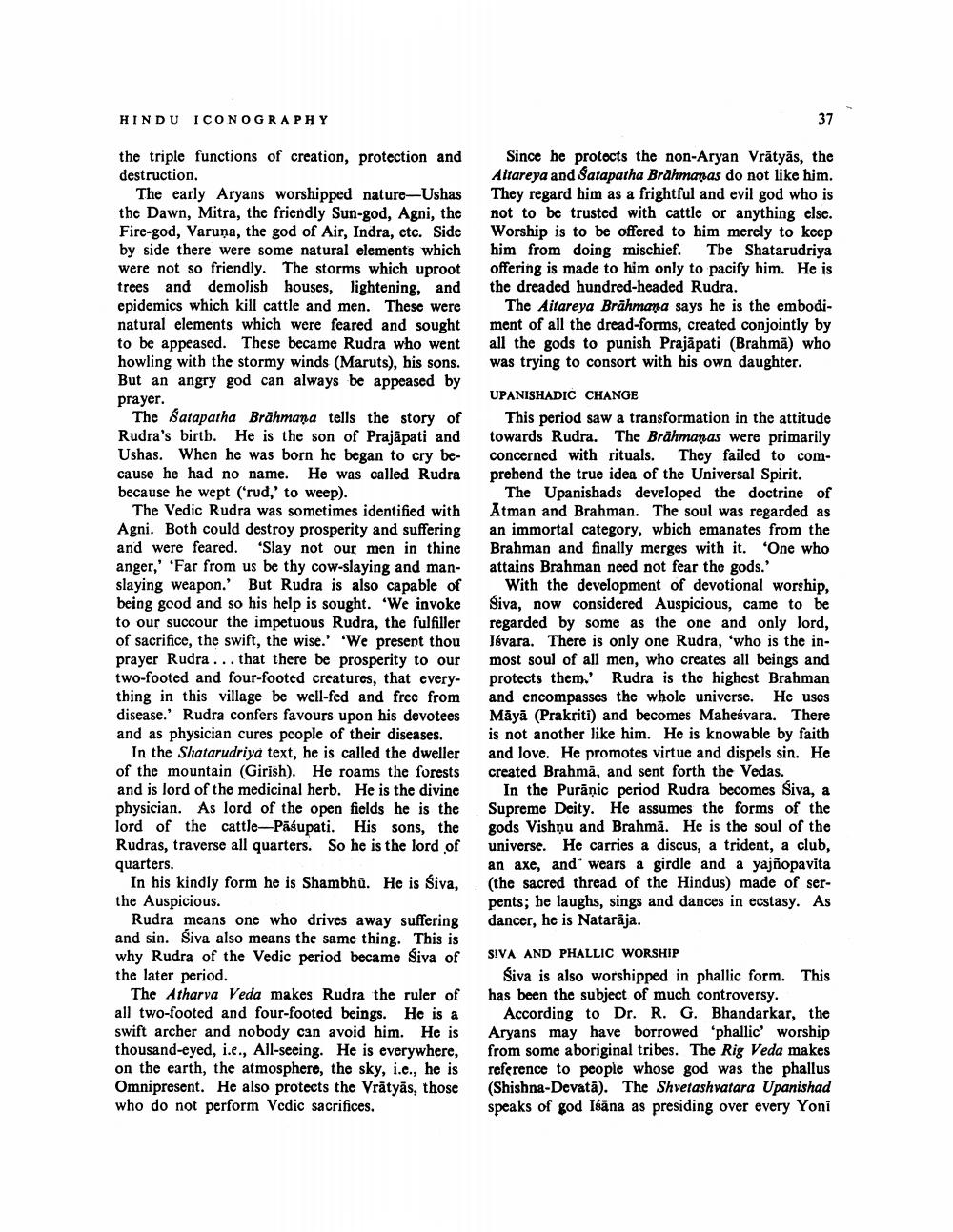________________
HINDU ICONOGRAPHY
37
the triple functions of creation, protection and destruction.
The early Aryans worshipped nature-Ushas the Dawn, Mitra, the friendly Sun-god, Agni, the Fire-god, Varuna, the god of Air, Indra, etc. Side by side there were some natural elements which were not so friendly. The storms which uproot trees and demolish houses, lightening, and epidemics which kill cattle and men. These were natural elements which were feared and sought to be appeased. These became Rudra who went howling with the stormy winds (Maruts), bis sons. But an angry god can always be appeased by
Since he protocts the non-Aryan Vrátyás, the Aitareya and Satapatha Brāhmaṇas do not like him. They regard him as a frightful and evil god who is not to be trusted with cattle or anything else. Worship is to be offered to him merely to keep him from doing mischief. The Shatarudriya offering is made to him only to pacify him. He is the dreaded hundred-headed Rudra.
The Aitareya Brāhmana says he is the embodiment of all the dread-forms, created conjointly by all the gods to punish Prajāpati (Brahmä) who was trying to consort with his own daughter.
prayer.
The Satapatha Brāhmana tells the story of Rudra's birth. He is the son of Prajāpati and Ushas. When he was born he began to cry be- cause he had no name. He was called Rudra because he wept ('rud,' to weep).
The Vedic Rudra was sometimes identified with Agni. Both could destroy prosperity and suffering and were feared. 'Slay not our men in thine anger,' 'Far from us be thy cow-slaying and man- slaying weapon.' But Rudra is also capable of being good and so his help is sought. "We invoke to our succour the impetuous Rudra, the fulfiller of sacrifice, the swift, the wise.' "We present thou prayer Rudra ... that there be prosperity to our two-footed and four-footed creatures, that everything in this village be well-fed and free from disease.' Rudra confers favours upon his devotees and as physician cures people of their diseases.
In the Shatarudriya text, he is called the dweller of the mountain (Girish). He roams the forests and is lord of the medicinal herb. He is the divine physician. As lord of the open fields he is the lord of the cattle-Pāśupati. His sons, the Rudras, traverse all quarters. So he is the lord of quarters.
In his kindly form he is Shambhû. He is Siva, the Auspicious.
Rudra means one who drives away suffering and sin. Siva also means the same thing. This is why Rudra of the Vedic period became Siva of the later period.
The Atharva Veda makes Rudra the ruler of all two-footed and four-footed beings. He is a swift archer and nobody can avoid him. He is thousand-eyed, i.e., All-seeing. He is everywhere, on the earth, the atmosphere, the sky, i.e., he is Omnipresent. He also protects the Vrátyás, those who do not perform Vedic sacrifices.
UPANISHADIC CHANGE
This period saw a transformation in the attitude towards Rudra. The Brāhmanas were primarily concerned with rituals. They failed to comprehend the true idea of the Universal Spirit.
The Upanishads developed the doctrine of Atman and Brahman. The soul was regarded as an immortal category, wbich emanates from the Brahman and finally merges with it. One who attains Brahman need not fear the gods.
With the development of devotional worship, Siva, now considered Auspicious, came to be regarded by some as the one and only lord, Jøvara. There is only one Rudra, 'who is the inmost soul of all men, who creates all beings and protects them. Rudra is the highest Brahman and encompasses the whole universe. He uses Māyā (Prakriti) and becomes Maheśvara. There is not another like him. He is knowable by faith and love. He promotes virtue and dispels sin. He created Brahmā, and sent forth the Vedas. I n the Purānic period Rudra becomes Siva, a Supreme Deity. He assumes the forms of the gods Vishnu and Brahmă. He is the soul of the universe. He carries a discus, a trident, a club, an axe, and wears a girdle and a yajñopavita (the sacred thread of the Hindus) made of serpents; he laughs, sings and dances in ecstasy. As dancer, he is Nataraja.
SIVA AND PHALLIC WORSHIP
Siva is also worshipped in phallic form. This has been the subject of much controversy.
According to Dr. R. G. Bhandarkar, the Aryans may have borrowed 'phallic worship from some aboriginal tribes. The Rig Veda makes reference to people whose god was the phallus (Shishna-Devatā). The Shvetashvatara Upanishad speaks of god Ibāna as presiding over every Yoni




